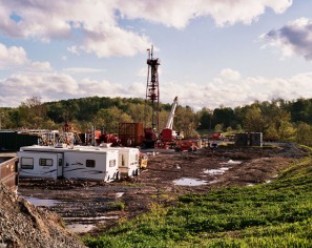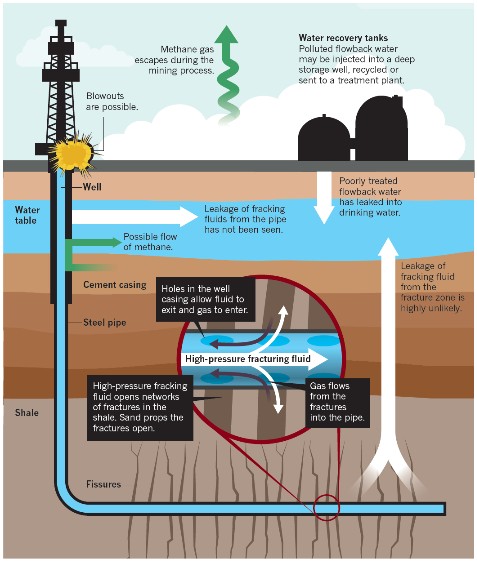
Early last year, I wrote an article, “Fracking the countryside”, questioning the merits of extracting natural gas trapped in shale rocks or coal seams via the process of hydraulic fracking.
This process essentially involves drilling and inserting a pipe deep into the ground and then pumping millions of litres of high pressure water and ‘fracking fluid’ into the shale rock or coal seam, causing it to fracture and releasing stored natural gas where it is then captured for energy production (see below image).

While natural gas is a relatively clean burning fuel, the process of fracking is highly controversial as it risks contaminating nearby water tables with both methane and fracking fluid, which is known to contain a number of carcinogens.
In that article, I attached two videos from the USA and Australia highlighting some of the potential deleterious impacts of fracking on the natural environment (click here to watch).
Yesterday, progressive think tank, The Australia Institute, released a report entitled “Fracking the future”, which attempts to bust gas industry’s myths about coal seam gas (CSG), while at the same time highlighting the potential health and environmental risks. Below are some key extracts from the Summary of the report:
There is heightened public concern about the environmental and health impacts of CSG extraction and the industry has met fierce opposition from a range of different groups. It has also met resistance from policy makers, with several governments enacting restrictions aimed at CSG projects…
The Victorian government was sufficiently worried about the effects of CSG that in 2012 it introduced a moratorium on hydraulic fracturing of rocks to release coal seam gas, a process also known as fracking. The NSW government introduced two-kilometre CSG exclusion zones around residential areas and banned CSG extraction in the Sydney water catchment area due to fears it might contaminate Sydney’s drinking water.
Despite these new regulations, the federal government is pushing to devolve responsibility for approving resource projects, including CSG projects, to state governments. This is part of the government’s push to reduce regulation, or so- called ‘green tape’, in the resources sector.
Results from The Australia Institute’s November survey1 found that the general public has a very different view from the government on how CSG should be regulated.
When asked about which level of government should regulate CSG, 71 per cent thought that the federal government should do it. When asked about the level of regulation of the CSG industry, 56 per cent wanted more regulation, with only seven per cent thinking there should be less regulation. This puts the general public’s views at odds with the federal government’s views.More CSG does not mean lower gas prices
The gas industry has claimed that the east coast of Australia is facing a gas crisis and that the solution is to fast track the expansion of CSG development. It claims the increase in supply will hold gas prices down. But these claims show a complete lack of understanding of what is causing prices to rise.
At the moment Australia’s eastern gas market, which includes Queensland, NSW, ACT, Victoria, Tasmania and South Australia, is not linked to the rest of the world. Eastern Australia has hitherto enjoyed low gas prices, since there was plenty of supply relative to domestic demand and no capacity to export gas from the east coast to international customers.
Recently, however, gas companies have begun construction on three large LNG facilities near Gladstone in Queensland. They will liquefy the CSG so that it can be shipped overseas. The overseas price of gas is far higher than the eastern Australian price and once the export facilities are completed, if customers in eastern Australia want to buy gas, they will have to match the overseas price minus the cost of liquefying and transporting the gas to Asia. This is also known as the export parity price. When the three export facilities are up and running this will triple the demand for gas.
While it is often the case that increasing supply of a domestic product will cause the price to fall, this is only the case, as economists say, ‘with all other things being equal’. In this particular case other things are not equal because eastern Australia is about to be connected to the much higher world price. The increase in supply will only reduce the price Australians pay if it lowers the world price, which is unlikely.
What’s really causing the price to rise?
What is interesting about the argument from the gas industry – that restrictions in supply are the cause of the rise in price – is that it was actually the increase in supply from CSG that led to the LNG export facilities becoming viable. Before CSG was discovered, the eastern market did not produce enough gas to make export a profitable venture…
With gas becoming far more profitable, it is not surprising that gas producers are keen to expand their supply. Blaming restrictions on CSG for coming price rises is a clever tactic, designed to turn public support against those restrictions and increase pressure for them to be removed. But these claims are little more than posturing and bear no resemblance to what is actually happening in the market…
Once Australia is linked to the world market, only factors that are capable of changing the world gas price will be sufficient to change the domestic gas price…
Evidence doesn’t support CSG as a solution to climate change
The claim that CSG will help Australia respond to climate change was rated as one of the top four benefits of CSG by the August survey respondents.3 The claim is that, when burnt, natural gas produces fewer greenhouse gas emissions than coal. While this is true, it overlooks concerns about greenhouse gas emissions associated with the extraction of CSG, chiefly fugitive emissions. There are also concerns about how methane, the main fugitive emission from CSG, is accounted for…
Health and environmental effects of CSG
The chemicals used in fracking are of public concern, especially given the quantities used. A CSG well in Australia will use about 18.5 tonnes of chemicals. These chemicals can have dangerous consequences, as was shown when an emergency room nurse died in the US after treating a patient who had been splashed with fracking fluid.
The evidence shows that there are environmental and health risks from fracking fluids, but because of the current lack of research they are difficult to quantify.
There is significant public concern about the contamination of aquifers by fracking chemicals. The evidence suggests that while gas is actively being extracted from the well the chances of contamination are low, so long as it is managed properly. But there is concern, and a lack of information, about stranded fracking fluids, which are fluids left in the ground after the well has been abandoned.
Contamination of aquifers is a real possibility and, like much of the research into the environmental and health impacts of unconventional natural gas, there are still many unknowns. Aquifers are a vital source of water and are important for the production of food. Risks of contamination need to be taken seriously and more research needs to be done…
CSG extraction has the potential to cause harm to the environment, farming land, water resources and human health. August survey respondents raised all these concerns and the available evidence suggests they have good reason to be worried.
The lack of research that has been done into the environmental and health impacts of CSG is alarming. If the gas industry is keen to expand and the government wants it to, then it should commit far more funding to quality research in this area.
Given the big question marks over the safety of fracking, including the risks posed to ground water stored in Australia’s Artesian Basin and the agricultural industry more generally, Australia would be wise to proceed with caution on CSG.

